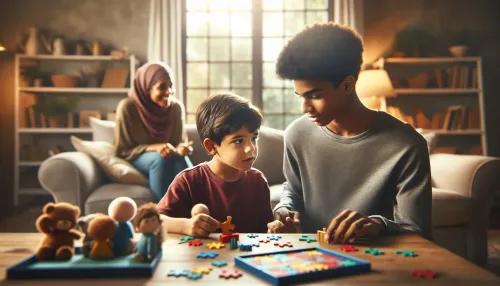
Practical Tips for Creating an Autism-Friendly Home Environment

Autism is a neurodevelopmental disorder that affects how a person interacts and communicates with others. Creating an autism-friendly home environment is crucial for the well-being of autistic children. Here are some practical tips to make your home a comfortable and supportive space for them.
Choosing Sensory-Friendly Decor and Furniture
Autistic children often have heightened sensory sensitivities. When selecting decor and furniture, opt for items that cater to their sensory needs. This may include soft, tactile fabrics, soothing color palettes, and minimalistic designs to reduce visual clutter. Additionally, consider investing in sensory-friendly furniture such as bean bags or rocking chairs, which can provide gentle sensory stimulation without overwhelming the child.
Establishing Calming Designated Spaces
Creating designated calming spaces within the home can provide a safe retreat for autistic children when they feel overwhelmed. These spaces can be equipped with cozy seating, comforting textures, and items that align with the child's specific sensory preferences. By having dedicated areas designed for relaxation, children can easily seek refuge when they need to decompress.
Organizing and Simplifying Living Areas for Optimal Sensory Comfort
Sensory overload can be distressing for autistic children. Organize living areas by minimizing clutter and maintaining a tidy environment. Ensure that there is ample space to move around freely without encountering obstacles. By simplifying the layout of living spaces, you can reduce potential sensory triggers and create a more comfortable atmosphere for the child.
Creating Visual Schedules and Cues for Routine Guidance
Consistency and structure are beneficial for autistic children. Introducing visual schedules and cues can help them navigate daily routines with greater ease. Use visual aids such as picture schedules or color-coded timetables to outline daily activities, transitions, and expectations. These visual supports serve as valuable tools for promoting predictability and reducing anxiety within the home environment.
Implementing Noise-Reducing Strategies
Noise sensitivity is common among autistic individuals. Implement noise-reducing strategies within the home by using sound-absorbing materials such as carpets, curtains, or acoustic panels to minimize excessive noise levels. Additionally, consider providing ear defenders or creating quiet zones where the child can retreat to when noise becomes overwhelming.
Utilizing Natural Lighting to Enhance the Living Environment
Natural lighting can significantly impact the comfort and ambiance of a living space. Maximize natural light exposure by keeping windows unobstructed and incorporating sheer curtains that allow diffused sunlight to enter the room. Natural light not only creates a soothing atmosphere but also positively influences mood regulation and sleep patterns for autistic children.
Setting Up a Safe and Secure Play Area
Designating a safe play area is essential for ensuring the well-being of autistic children. Choose age-appropriate toys and equipment that align with their interests while prioritizing safety. Consider using soft padding or mats to cushion play surfaces and minimize potential hazards. Creating a secure play environment provides opportunities for sensory exploration and active play in a protected setting.
Designing a Quiet Retreat Space for Relaxation
Incorporate a dedicated quiet retreat space where autistic children can unwind and engage in activities that promote relaxation. This space can include cozy seating, weighted blankets, calming sensory toys, or soothing elements such as gentle music or nature sounds. Designing a tranquil retreat allows the child to self-regulate their sensory experiences while finding solace within their home environment.
As you implement these practical tips, remember that every autistic child has unique sensory preferences and comfort requirements. Being attentive to their individual needs and observing how they respond to different environmental elements will guide you in creating an autism-friendly home environment tailored specifically to support their well-being.
By following these strategies, you can foster a nurturing home environment that acknowledges and accommodates the sensory needs of autistic children, promoting a sense of security, comfort, and overall well-being within the family setting.
This blog article is crafted in compliance with the guidelines outlined by "HorizonsMind Blog" to ensure relevance to its audience interested in "Autistic Children.
Check Out These Related Articles


Uniting Communities: Strengthening Family Support Systems for Autistic Children of Diverse Backgrounds

Organizing Successful Outings: Proven Strategies for Enjoyable Trips with Autistic Children
